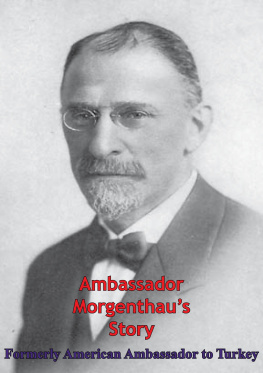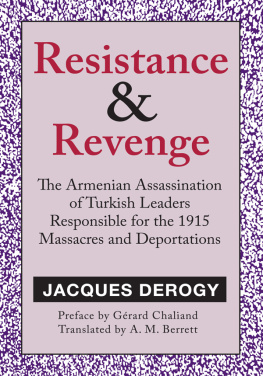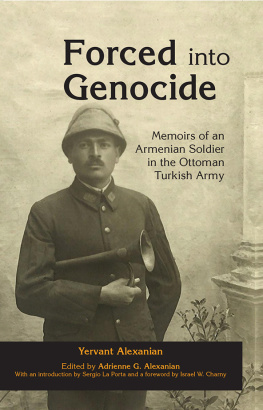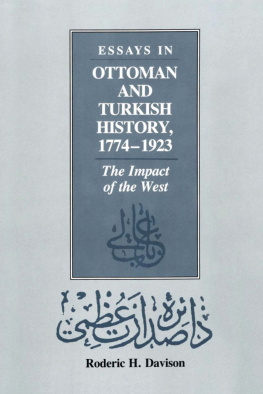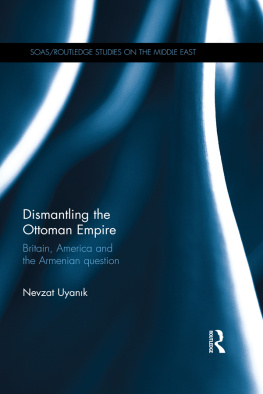
Armenian Organization and Ideology under Ottoman Rule 1908-4914
Revised Edition
Armenian Studies
Gerald J. Libaridian, Series Editor
Cultivating Nationhood in Imperial Russia
The Periodical Press and the Formation of a Modern Armenian Identity
Lisa Khachaturian
Armenian Organization and Ideology under Ottoman Rule
1908-1914
Dikran Mesrob Kaligian
The Armenian Genocide
Cultural and Ethical Legacies
Richard Hovannisian, editor
The Pain of Knowledge
Holocaust and Genocide Issues in Education
Yair Auron
Modern Armenia
People, Nation, State
Gerald J. Libaridian
The Banality of Denial
Israel and the Armenian Genocide
Yair Auron
Looking Backward, Moving Forward
Confronting the Armenian Genocide
Richard G. Hovannisian, editor
The Banality of Indifference
Zionism and the Armenian Genocide
Yair Auron
Warrant for Genocide
Key Elements of Turko-Armenian Conflict
Vahakn N. Dadrian
Armenian-Americans
From Being to Feeling Armenian
Anny Bakalian
Judgment Unto Truth
Witnessing the Armenian Genocide
Ephraim K. Jernazian
Resistance and Revenge
The Armenian Assassination of Turkish Leaders Responsible for the 1915 Massacres and Deportations
Jacques Derogy
The Armenian Genocide in Perspective
Richard G. Hovannisian, editor
Armenian Organization and Ideology under Ottoman Rule 1908-4914
Revised Edition
Dikran Mesrob Kaligian
Originally published in 2009 by Transaction Publishers.
Published 2017 by Routledge
2 Park Square, Milton Park, Abingdon, Oxon OX14 4RN
711 Third Avenue, New York, NY 10017, USA
Routledge is an imprint of the Taylor & Francis Group, an informa business
New material this edition copyright 2011 by Taylor & Francis.
All rights reserved. No part of this book may be reprinted or reproduced or utilised in any form or by any electronic, mechanical, or other means, now known or hereafter invented, including photocopying and recording, or in any information storage or retrieval system, without permission in writing from the publishers.
Notice:
Product or corporate names may be trademarks or registered trademarks, and are used only for identification and explanation without intent to infringe.
Library of Congress Catalog Number: 2011007162
Library of Congress Cataloging-in-Publication Data
Kaligian, Dikran Mesrob.
Armenian organization and ideology under Ottoman rule, 1908-1914 / Dikran Mesrob Kaligian.
p. cm.
ISBN 978-1-4128-4245-7
1. Armenians--Turkey--Politics and government--20th century. 2. Turkey-Politics and government--1909-1918. 3. Turkey--Ethnic relations--History--20th century. 4. Armenian massacres, 1909. I. Title.
DR435.A7K355 2011
305.891992056109041--dc22
2011007162
ISBN 13: 978-1-4128-4245-7 (pbk)
ISBN 13: 978-1-4128-0775-3 (hbk)
In memory of
Mesrob Khaligian of Khoups
Vahan Tamzarian of Aleppo
Andreas Oganian of Yerevan
Table of Contents
Chapter ITriumph to Tragedy:
From Constitutional Restoration to the Adana Massacres, July 1908-April 1909
Over the years, a number of organizations and individuals generously provided their assistance as this work was researched and written. The research would have been impossible had it not been for the access I was granted to its archives by the Bureau of the Armenian Revolutionary Federation. I wish to express my thanks to the Bureau and especially to the individuals responsible for the archives, Tatul Papazian and Garo Armenian, for their assistance.
I owe a great deal to my teachers. When I studied in Lebanon, it was Anas Barsoumian who helped me greatly improve my Armenian. While there I learned of the history, structure, and ideology of the ARF from Papken Papazian, Sarkis Zeitlian, and Varant Papazian, as well as Hratch Dasnabedian, whose writings on the party blazed the trail that I have followed. At the University of Massachusetts, Harold Gordon helped inspire a love of history and at Boston College, James Cronin and Paul Spagnoli trained me in its practice.
I shall always be indebted to the members of my dissertation committee, Benjamin Braude, John Heineman, and Feroz Ahmad. Feroz Ahmad truly went above and beyond what one might reasonably expect as he responded to a request for sources by volunteering to advise me in my research and contributing numerous helpful suggestions along the way. I also gratefully acknowledge Vahakn Dadrian, Hratch Zadoian, Stephan Astourian for all the advice and direction he provided, and Hagop Hachikian for his translations of Turkish sources.
Jirayr Libaridian graciously chose to include this manuscript in the Armenian studies series. Irving Louis Horowitz and the staff at Transaction Publishers patiently ushered it to publication. The map in this volume is from the British Governments The Treatment of Armenians in the Ottoman Empire, 19151916.
Finally, my family both supported me and contributed their talents. My first knowledge of the ARF, I received from my father. The assistance of my mother was invaluable, both in doing translations and in deciphering some nearly unintelligible handwriting. My sons, Keri and Rosdom, and my daughter, Yeraz, did not see as much of their father as they should have while this book was being written. I hope when they are old enough to read it, they will find it worthwhile and that the boys will learn of their namesakes within its pages. But the greatest part of the burden fell on my wife, Seda. Without her support and encouragement during the years it took to complete this work, these pages would have remained blank.
This paperback edition has been revised from the original hardcover to include minor changes at the end of the first chapter. There are substantial additions to the end of the sixth chapter that correct some of the misinterpretations in the historiography of the ARFs stance in case of war and the ARF-CUP negotiations in Erzerum in the aftermath of the World Congress.
ARF Structure Between the Fifth and Seventh World Congresses 19091913
ARF Structure Between the Seventh and Eighth World Congresses 19131914
At the start of the twentieth century, the territory of historical Armenia was divided between the Ottoman and Russian Empires. The Armenians were allowed a limited measure of autonomy under Ottoman rule. However, in governmental and judicial matters and in relations with Muslims, Armenians were clearly second-class subjects. When Armenian political parties began demanding improved conditions for the Armenian populace, amplifying decades of demands by the community, the government of Sultan Abdul Hamid II responded by initiating or encouraging a series of massacres from 18941896 that killed hundreds of thousands across the empire.


